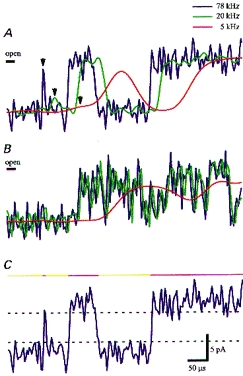Figure 2. Single channel patch clamp currents recorded on-cell from mouse myotubes with 10−5m ACh (A and C, same records) and 2 × 10−3m ACh (B).

Polarization, −200 mV; 21 °C. The blue traces are filtered with a 78 kHz low pass filter, the green ones with a 20 kHz filter and the red ones with a 5 kHz filter. The ‘open’ level (bar) corresponds to 9.5 pA. B, 2 × 10−3m ACh elicits a burst broken up by ten short closings due to channel block by the high ACh concentration. At 5 kHz filter cut-off the closings are not resolved and apparently channel current amplitude is reduced with a relatively noisy open channel. C explains the evaluation of current traces. A dashed upper threshold line is placed at 0.8 full amplitude at the lower margin of the open channel trace; when the current passes this upper threshold coming from the closed state, the program detects a channel opening. Vice versa, passing of the lower threshold at 0.2 full amplitude terminates the open state and a closure is detected. The program stores the time sequence of openings and closures as an ‘idealized trace’ shown above. The duration of a specific opening or closure is determined at half-amplitude.
